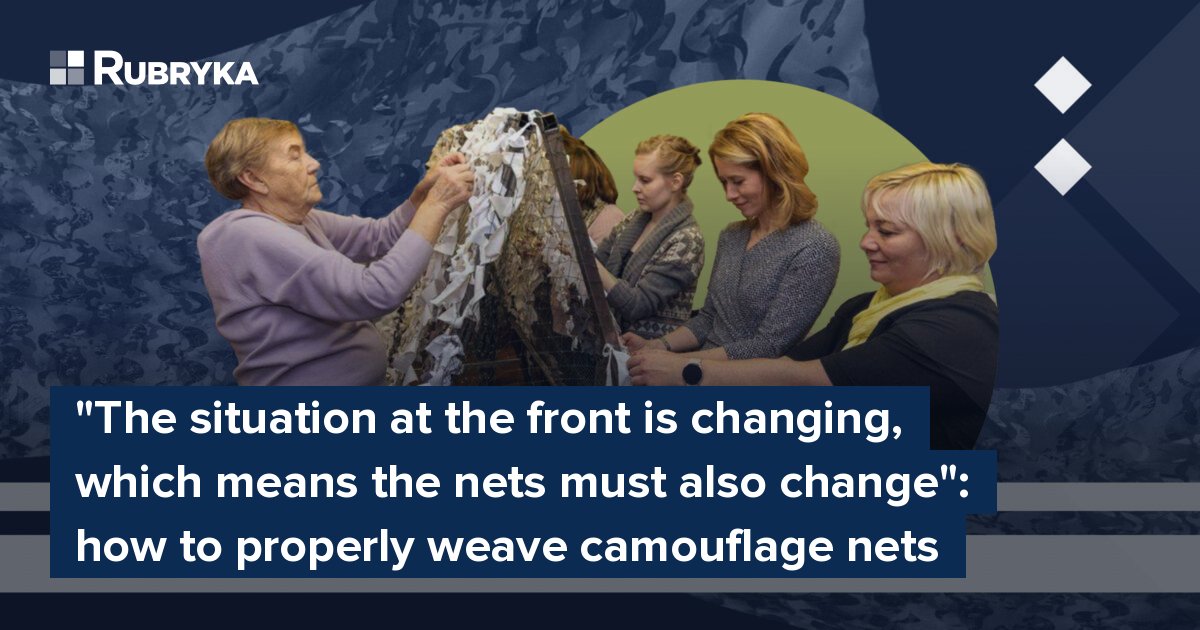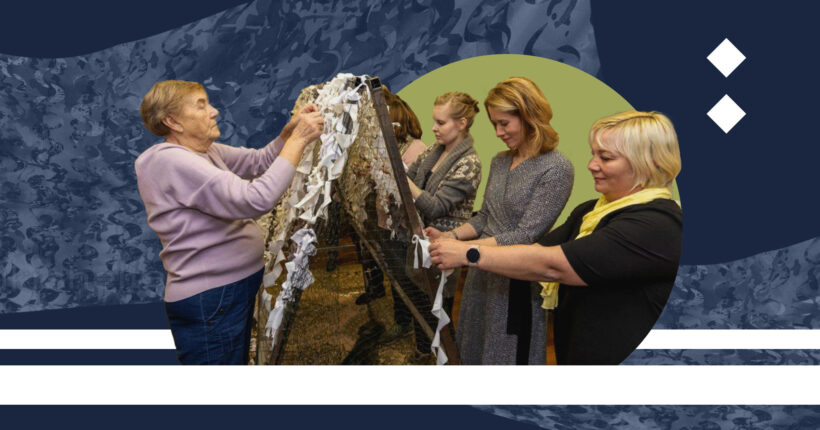
What is the problem?
Since the beginning of the war, camouflage nets woven by hundreds of volunteers throughout the country have been protecting Ukrainian soldiers at the front. Only the colors change: green in spring and summer, yellow in autumn, and white in winter. The geography of hostilities, where camouflage nets serve, is also changing. In the Sumy, Kharkiv, Donetsk, Kherson, and Zaporizhzhia regions, soldiers of the Armed Forces of Ukraine hide equipment, dugouts, and trenches from the enemy's eyes under camouflage nets. Nets often save the lives of fighters for Ukraine's peace and freedom. However, no matter how many volunteers make them, there are always not enough camouflage nets. They wear out and tear, cease to correspond to the season, and more and more new equipment that needs protection arrives at the front.
What is the solution?
In Ukraine
Hundreds of volunteer centers have been created in Ukraine during the war, where people of different ages weave nets for Ukrainian soldiers.
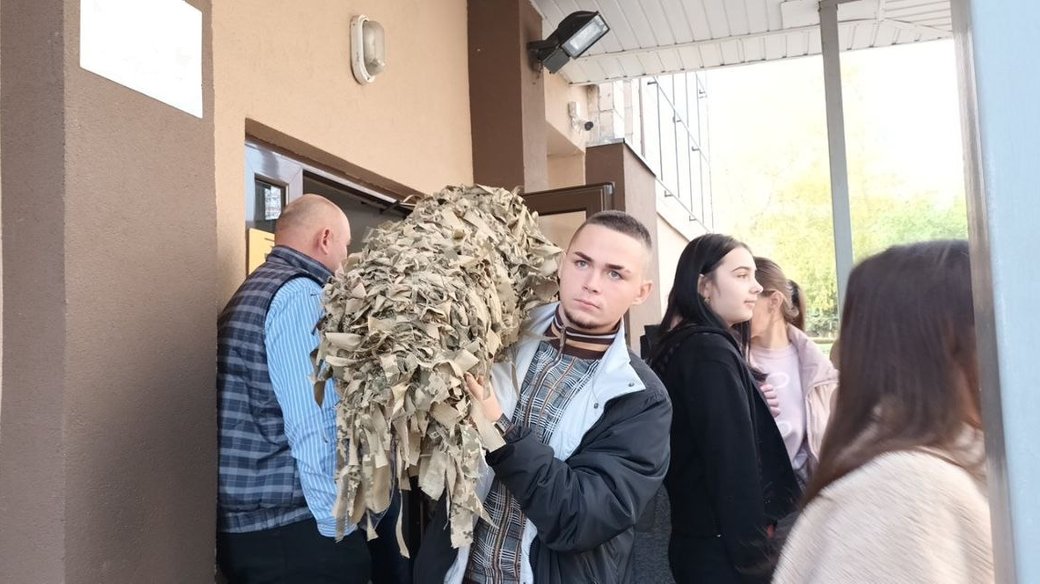
Students of the Faculty of History of the Ternopil Pedagogical University with the nets they made.
In Ternopil, the Faculty of History of the Ternopil Pedagogical University students have been weaving camouflage nets for Ukrainian soldiers on the front lines since 2014. In total, they created and handed over 1,254 nets to the soldiers. The total area of these nets is more than 40,000 square meters. Nets are woven together with volunteers who come to the faculty to help.

Volodymyr Kitsak paints old, mostly white, sheets and scraps of fabric. His daughter Mariia helps him.
Volodymyr Kitsak, dean of the Faculty of History, dyes fabric for camouflage nets in his spare time at home. To dye the material, he first used 40-liter pots, and now he does it with the help of a washing machine, which he installed in his garage. A volunteer from Italy handed over the washing machine to Kitsak in April 2022, and the transport company agreed to transport it for free.
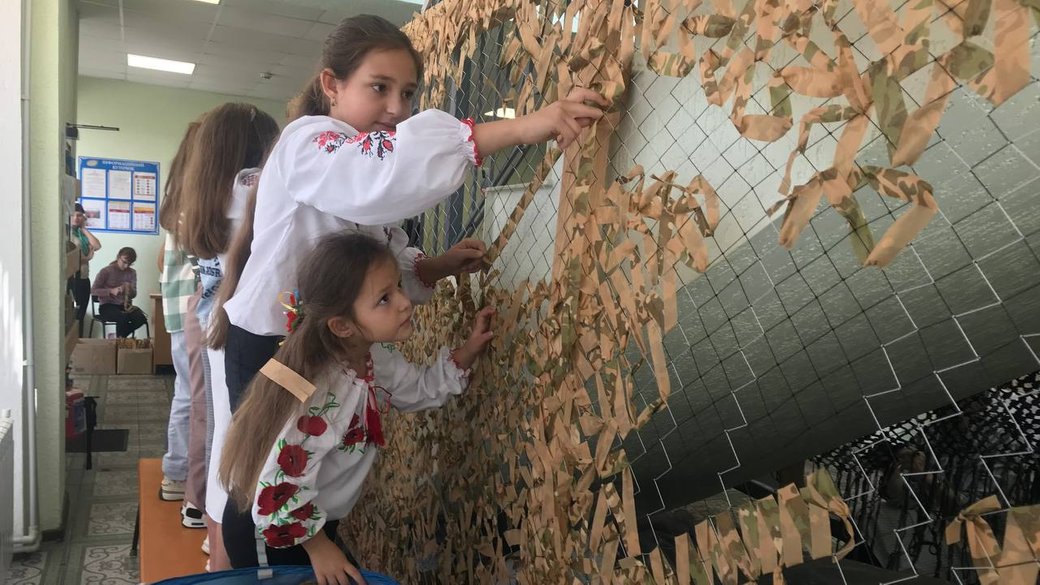
In Zhytomyr, children help adults weave nets. Photo: Anzhelika Nesterchuk
In Zhytomyr Central City Library, children weave camouflage nets with adults. They make up to 30 nets every month. According to Yuliia Kovshun, director of the LITtera city public libraries, the library employees were the initiators of weaving camouflage nets from the first days of Russia's full-scale invasion. Later, children and library visitors joined in.
"I started weaving nets in June and continue to do so until today. I don't want enemy planes to fly over Ukraine, and I believe that our defenders will return home alive," says library reader Yeva.
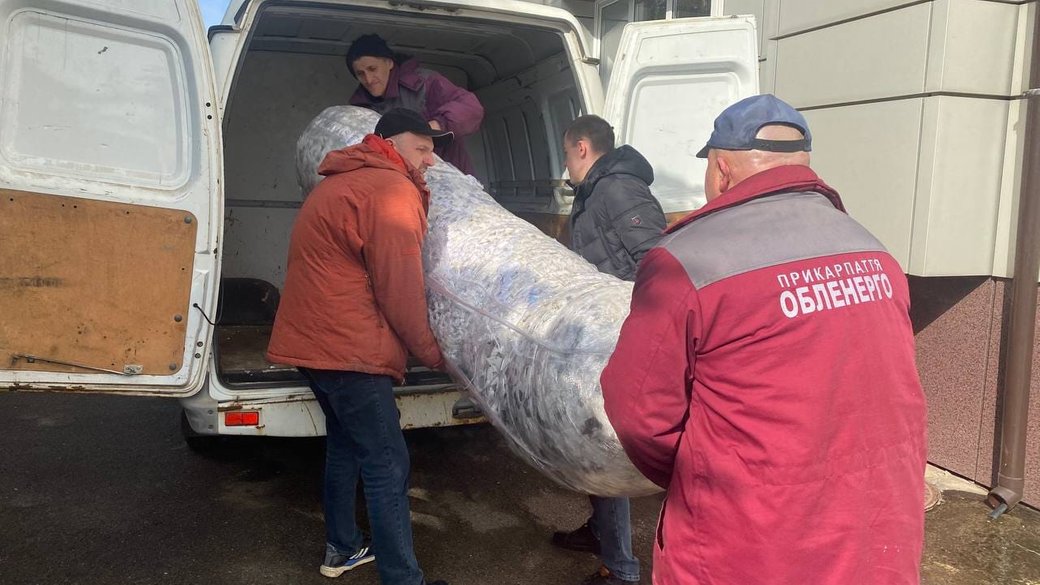
The net, woven by the energy infrastructure workers, is transferred to the front. Photo: Facebook/Prykarpattiaoblenergo
In the Ivano-Frankivsk region, energy infrastructure workers have also been handing camouflage nets to the armed forces soldiers since the beginning of the full-scale invasion of the Russian Federation. During the lunch break, colleagues gather to switch off from hard work and spend time with benefit for the army. Since February, the careful hands of the company's employees have woven hundreds of square meters of nets. Employees of Prykarpattiaoblenergo say they believe that their nets will become not only protection but also a lucky charm for the quick victory of the Ukrainian military.
"Weaving camouflage nets became the first initiative to help our army," says Olha Tyshko, head of the regional energy trade union committee. Already on February 26, they gathered, setting up a shop in the company's central office. First, they met with NGO Warrior's Wife team to learn a new craft and start production. Then, they actively began to work, which continues to this day. "Work helps to clear the mind daily and adds self-respect to each volunteer worker. After all, everyone is doing everything possible to protect the soldiers and bring Ukraine's victory closer!"
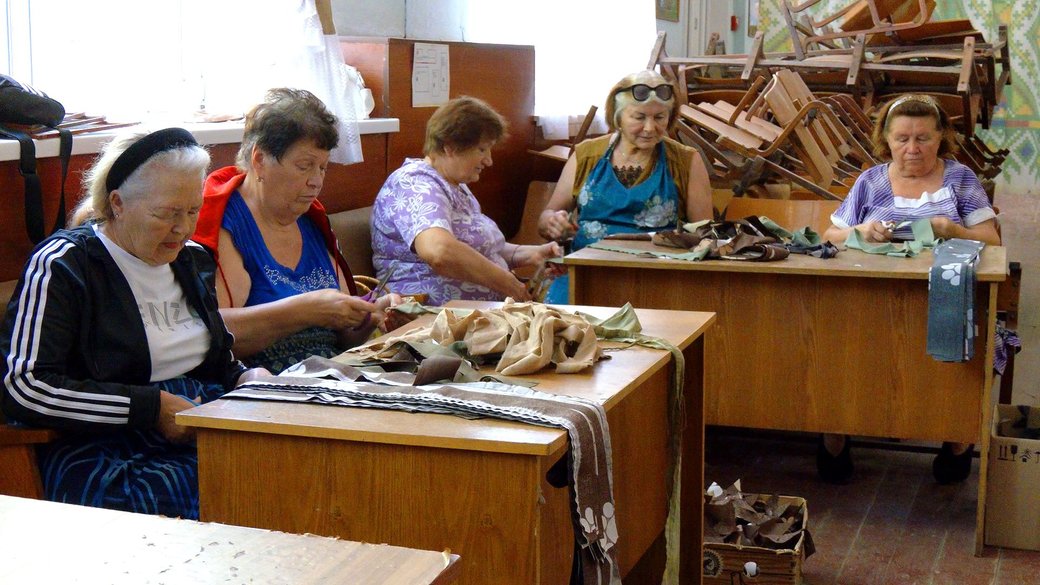
In the cultural center of the Luka-Meleshkivska community in the Vinnytsia region, mainly retired women work on creating nets. The center is open seven days a week, and the visitors manage to make one net daily. The elderly volunteers say they come to weave nets every day for the second year in a row: "We're already used to it, we come and already know our places, we sit down, we work."
Since the start of the full-scale invasion, this volunteer center has woven and handed over a thousand camouflage nets of various sizes to the soldiers.
Abroad
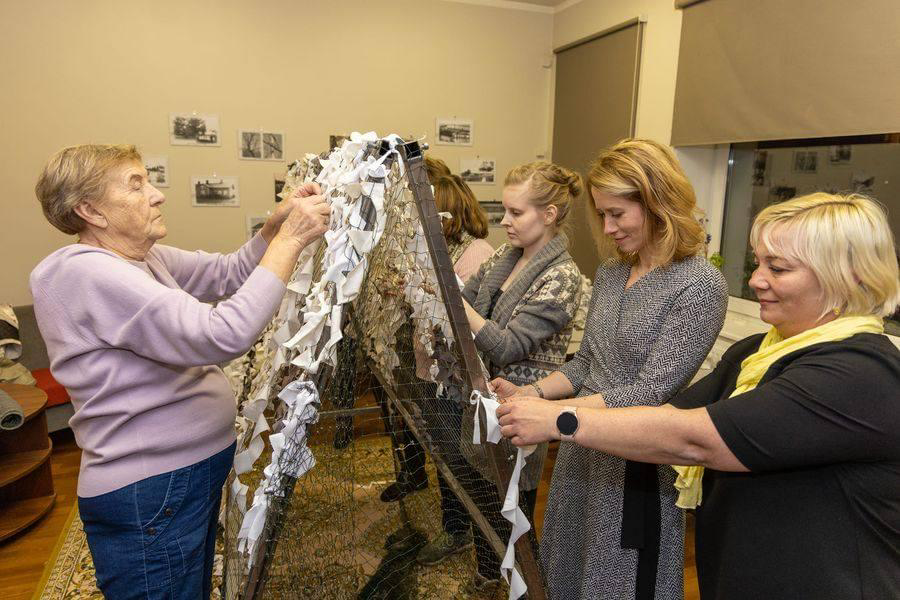
Weaving camouflage nets in the suburbs of the Estonia's capital.
People outside Ukraine join in weaving camouflage nets for the Ukrainian army. For example, ladies from the Estonian town of Saue, located not far from Tallinn, also weave camouflage nets for Ukrainian defenders. Once, even the Prime Minister of Estonia, Kaja Kallas, joined them.
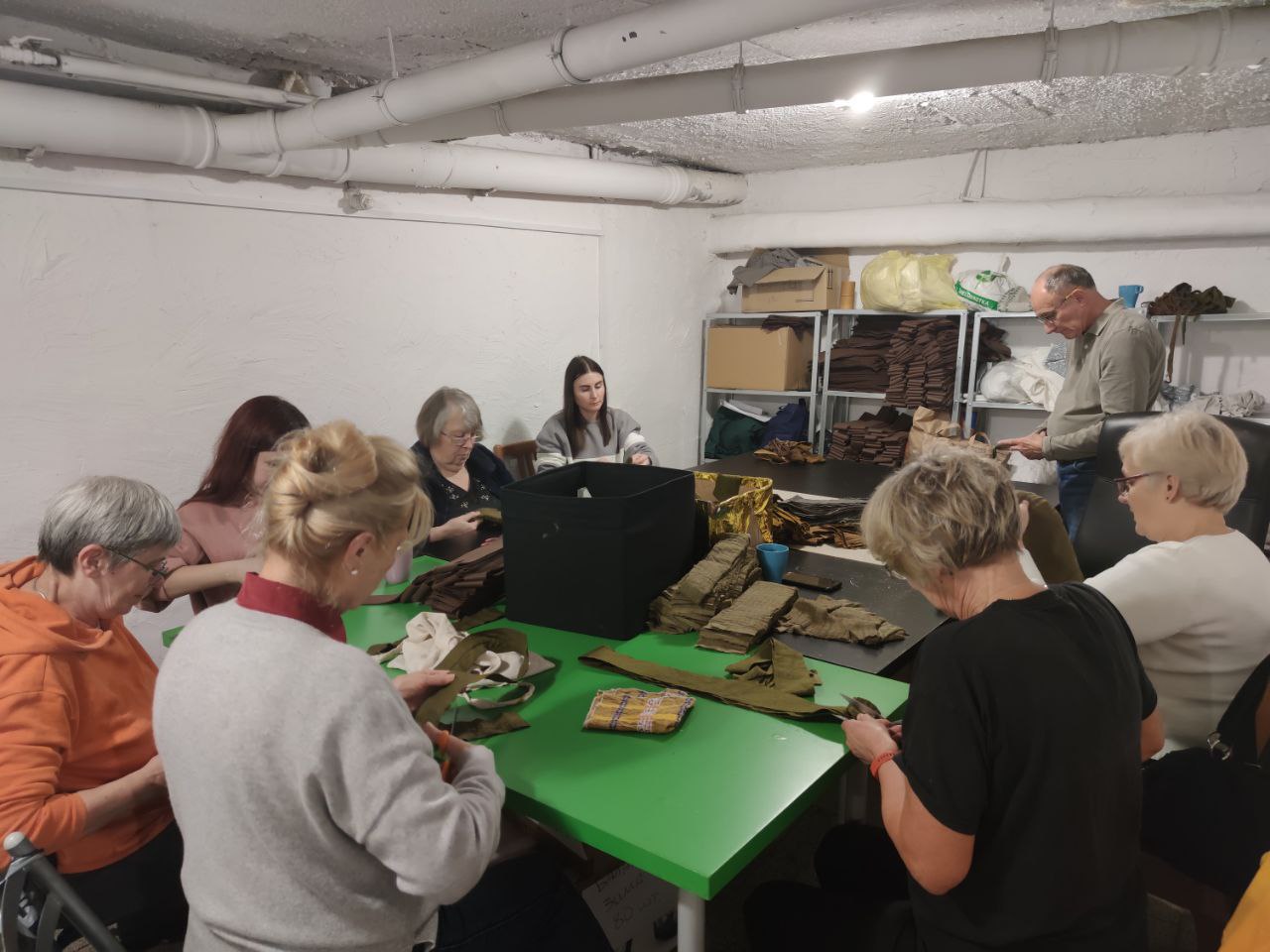
Female volunteers in Warsaw cut fabric for camouflage nets for the Armed Forces of Ukraine.
In Warsaw, volunteers gather weekly to weave camouflage nets for the military from Ukraine. The Sitky_Warszawa center has been in existence for over a year. Over 5,000 square meters of camouflage nets were made here during this time. All donations collected at the center are spent exclusively on materials.
It seemed that it would be more convenient and efficient to make nets as close as possible to the units and brigades that order them. But the help of Ukrainian volunteers is essential — there are four centers in Warsaw, and all of them are overflowing with orders, the number of which is not decreasing. Polish friends have dozens of nets in line daily, requiring hundreds of person-hours to make. They weave nets in Warsaw on weekends from 14:00 to 21:00, and everyone is invited to join this important cause. In the center's Telegram channel, one can follow all the news, changes in the schedule, and even prize draws — the soldiers often send souvenirs in return, which are then raffled among community members. Making nets is not tricky, volunteers say. Knowing how to knit or sew is unnecessary, and anyone can become a skilled weaver on the first day of work.
You, too, can join in!
Olha Kuzakova, a volunteer from the Kyiv region, the founder and head of the volunteer center Pavuchky of Borshchahivka, says that to weave nets, one doesn't need to be born an ace. Anyone who wants to bring Ukraine's victory closer can learn the science of weaving because experienced volunteers always need more workers.
"The full-scale invasion of Russia made every Ukrainian think about what they could do to help their country, the army, and fellow citizens," says Kuzakova. "The initiative to weave camouflage nets Pavuchky of Borshchahivka was created in February 2023 as a response to the front's crazy demand for camouflage because it turned out that the state does not cover these needs."
Pavuchky of Borshchahivka

Pavuchky of Borshchahivka with a woven net.
From the beginning of the war until today, residents of Sofiivska Borshchahivka, the Kyiv region, tirelessly weave camouflage nets, working in 3 to 4 shifts daily, constantly improving technology and skill. The Pavuchky of Borshchahivka team already has three branches and unites more than 70 caring residents of Borshchahivka territorial community and even some districts of Kyiv. In addition to the primary goal of protecting soldiers from the enemy's eye, the Pavuchky of Borshchahivka also gained an additional, but no less valuable, purpose: the socialization of resettlers. In the centers of the initiative, the latter find friends and like-minded people and go for walks together. This helps displaced people not close themselves within the four walls and not stay alone with their problems.
The team weaves nets according to the individual orders of military personnel — exactly the ones they need, and only for the front line, selecting materials and colors depending on the location and purpose. "We always ask for feedback to ensure that we have done everything possible for the best possible visual protection of military positions or equipment and, if necessary, to adjust our actions for the future," says Kuzakova. In the volunteer center, she takes care of fundraising, collects donations for materials, communicates with suppliers, directly accepts orders from the military, and asks for feedback.
During the entire existence of Pavuchky of Borshchahivka, 12,983 square meters of camouflage nets have been woven. This equals 541 nets for SUVs — a minimum of 2,164 lives saved, or 216 nets for a medium tank. The most miniature net — 1×1 meters is for masking Starlinks, and the largest is 19×10 and 15×12 meters — for a fuel truck and an air defense complex.
At Rubryka's request, Kuzakova described what a correct net should look like, what mistakes should be avoided, and how to organize a successful center in your school, company, or community.
How does it work?
What is the ideal net?
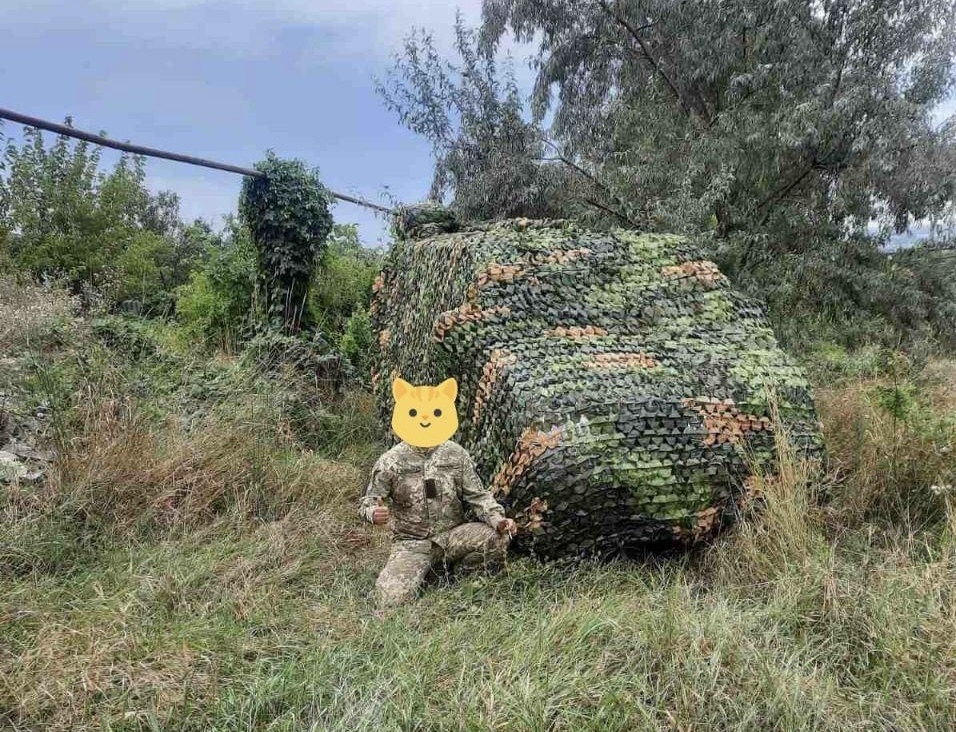
The colors of the net should blend in with nature.
Kuzakova advises that everyone interested in making high-quality nets should first find as much information about it on the Internet as possible — what materials to buy, what weaving technique to use, and other essential nuances discovered and developed by experienced Ukrainian volunteers during the war between the Russian Federation and Ukraine.
A high-quality masking net must meet the following quality criteria:
1. High-quality visual masking.
- It is necessary to understand what the net should protect against — a drone, a camera, visual hunting, and a night vision device. Each point will make its own adjustments to the finished product and affect the choice of materials, the density of weaving, and the weaving technique. Also, for example, few people think that cameras on drones can't see in night mode, and if you use a material that colleagues have not tested, then ideally, you should have your own night vision device and check whether the material is suitable. This should be done in a location similar to where the net will be used. The main thing is that the object it masks should not be seen through.
- Colors should blend naturally with a specific location — that is, you can't use blue or leopard-print fabric, for example. It is better to spend more time and collect money for a roll of spunbond and give the military four nets instead of ten.
2. Low windage.
Achieving low windage is also possible only by self-testing or consultation with more experienced colleagues. There are many critical technical points here: for example, for most ribbon-cutting techniques, the ratio of the width of the ribbon to the cell of the base is 0.8, but for the Herringbone technical cutting, this indicator is already one.
3. Endurance. Durability and resistance to wear and weather conditions.
If it is the masking of a static object, even a stitched mesh made of perforated spunbond is sufficient. However, if the net is used to hide equipment that will move, then the net should not unravel if caught on a branch at speed. This can be achieved by selecting a base and a particular way of cutting ribbons for weaving.
4. Mobility.
The net should be light and portable. The military should spend a minimum of time deploying it.
5. Reliability of fasteners.
The net should not detach under the influence of wind or other factors. For a secure attachment, it is crucial to take a strong fabric, weave it into the net, and make a functional loop so that the military can hook the net and it would not come off.
Errors that Pavuchky of Borshchhaivka went through:
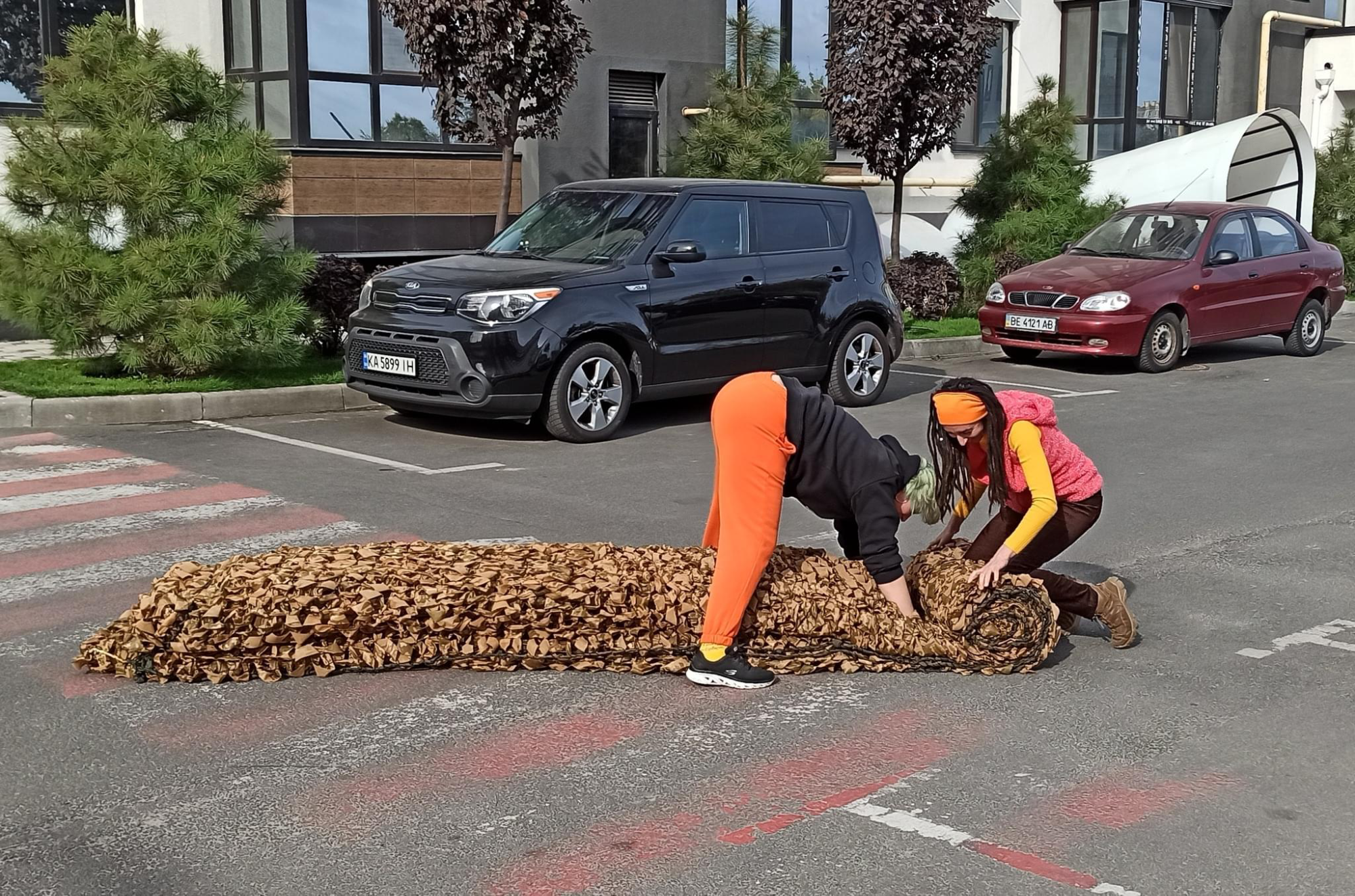
The net should be light and portable.
- Using cotton as a material for weaving. Cotton nets do not meet two quality criteria at once. They are not portable because they become very heavy and bulky when they get wet.
- In addition, the quality of visual masking when using this material is a big question. Kuzakova recalls that at the beginning of their activity, the volunteers tried to dye cotton in the desired colors independently, but it was impossible to know the resulting shade.
- Another annoying shortcoming is that when the military ordered the net not through volunteers, the volunteers initially did not take an alternative contact of someone from the unit. "Unfortunately, this is war, and it happens that the military stops communicating. So that the unit is not left without nets, it is necessary to have an alternative contact," emphasizes Kuzakova.
How to organize a successful center for weaving camouflage nets?
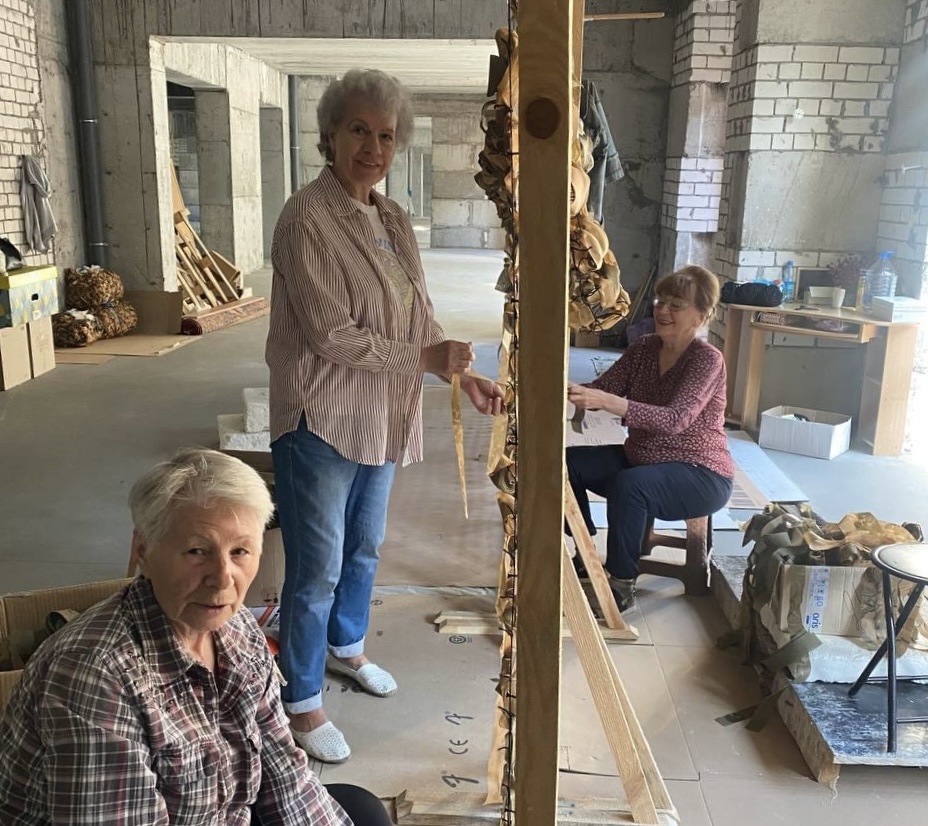
A good mood is half the success.
- Find a comfortable and warm room.
- Organize the fundraiser for materials.
- Attract new people to weaving nonstop. Distribute information about yourself on social networks and put up printed ads.
- Organize training of new members of the organization — as a result, you will have the predicted quality.
- For effective work, work areas must be clearly divided, and leaders and permanent executors must be assigned to each area. For example, in Pavuchky of Borshchahivka, in addition to the weaving department, the team has a separate department for cutting materials because this is also a large part of the work, which is not tied to the place of execution. This allowed several neighbors of the center to set up a cutting machine right on their floor to ensure the uninterrupted work of the weaving group and timely and high-quality fulfillment of orders for camouflage nets.
- Always asking the military what can be improved in the nets.
Kuzakova adds that it is perfect if there is a person in the center who monitors the team's general mood, takes care of a good atmosphere, and resolves conflict issues within the group. This is important to retain people and to maintain production capacity at a steady level. Also, even the most experienced team members need to learn and improve constantly.
"There are many educational videos on the Internet. You just have to not wear a crown and think you have mastered everything because the situation at the front is changing, which means that the nets must also change. Also, it is necessary to analyze the information," Kuzakova explained to Rubryka. "For example, recently, the front line has not moved for a long time, which means that everything there does not look like what we are used to seeing in the forest or the field. Winter is still upon us, and the leaves are gone. This means that making nets with denser visual masking is necessary without increasing the windage."
Even more useful solutions!
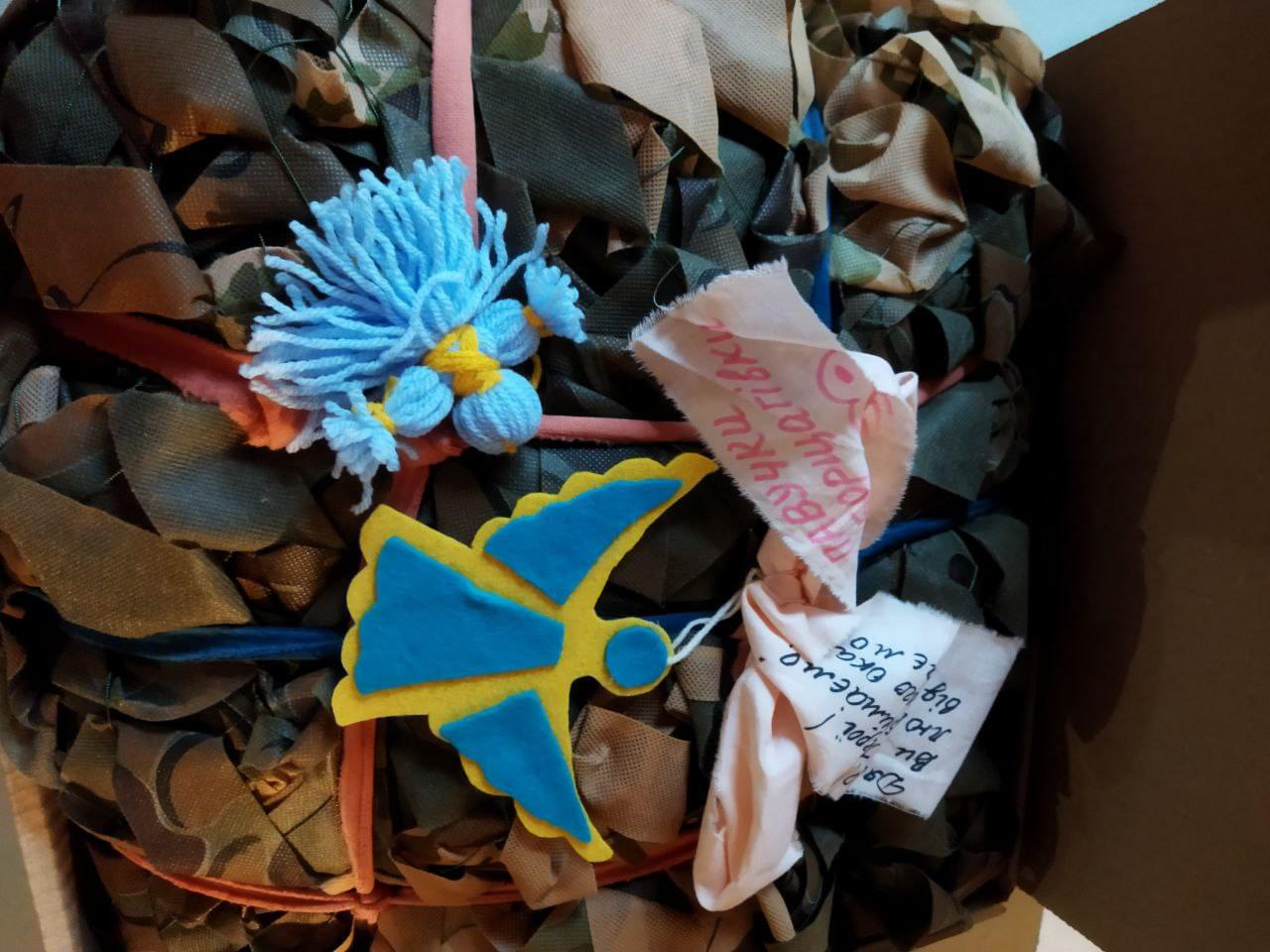
Pavuchky of Borshchahivka team sends charms for soldiers along with nets to the front lines.
"I encourage everyone who wants to volunteer, and this applies not only to weaving. In addition to a united front and obvious benefits for the country, volunteering also provides an opportunity to try something other than paid work," Kuzakova continues. "In particular, in our centers, a lot of work can be done without being near us. Maybe you wanted to create promotional materials or master SMM or fundraising. You can get new knowledge and immediately put it into practice. And your resume will have another important line not only with courses but backed up by practice. As a personnel management manager, this is a perfect option to gain experience and change the profession to the desired one in the future," says Kuzakova.
Now Pavuchky of Borschahivka is in great need of sewists with sewing machines at home. They also collect children's drawings and amulets, which they put in their shipments with camouflage nets. Such heartwarming souvenirs support the soldiers at the front and remind them they are waited for at home and remembered. Soldiers carry them and hang them in dugouts and inside armored fighting vehicles and tanks.
If you want to volunteer, help the center, or send drawings or amulets that the volunteers will include in the next packages to the soldiers, you can contact the head of the organization, Olha Kuzakova, at the number 063 569 30 58. Kuzakova also adds that she is ready to share the discounts from suppliers with other centers (up to 40% discount on some items) and order materials on her behalf to the necessary address.
Together toward victory!


